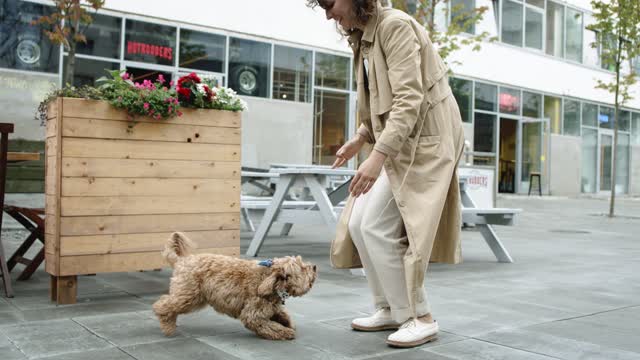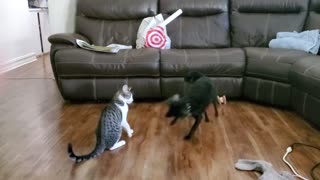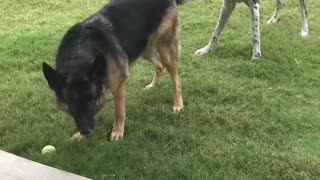Premium Only Content

Dog And Human Best Friends Is The Best Thing You'll See All Day
do you really know how to play with Your Dog ?
Fantasy #1: Don't Mix Dog Training And Play.
False! It's really extraordinary to consolidate play into canine instructional courses. The best canine preparing happens when the canine perspectives a movement as a game as opposed to an exercise. Utilizing pursue games to show played, follow to construct a base for behaving, utilizing pull to rehearse "take it" and "drop it," and rehearsing stays with "discover it" games or find the stowaway are altogether extraordinary approaches to mix preparing and play. Moreover, play is strengthening, so playing with your canine might be superior to the best treat.
Fantasy #2: Only Young Dogs Need To Play.
False! A little level of creature species play by any stretch of the imagination, and significantly less play past youth. Canines and individuals stay energetic into adulthood, which may mostly clarify why we've been closest companions for millennia. Numerous more established canines quit playing simply because they at this point don't have pals to play with. Continue playing with your canine well into mature age. It's important for what makes them canines and us human!
Fantasy #3: Don't Play Tug With Your Dog.
In particular, I can't help contradicting this restriction (in any event for most canines). Numerous individuals exhort against playing pull, which is a disgrace on the grounds that such countless canines worship it. Pull is an extraordinary game, and canines can gain so much from playing it. Numerous mentors share this view and really instruct pull in doggy classes. The prior canines gain proficiency with the exercises that pull has to bring to the table, for example, drive control, mouth control and collaboration just as abilities like "take it" and "drop it," the more secure and more fun the game becomes.
For quite a while, specialists exhorted against playing pull with canines for dread that it would make or expand forcefulness in canines. Afterward, pull was viewed as fine for most canines as long as they were not permitted to "win" by keeping the toy toward the end. The worry was that it would have terrible ramifications for her to feel she had recently prevailed over the individual.
A logical report by Rooney and Bradshaw tended to this issue. They found that "triumphant" the toy in a round of pull had no effect on the relationship of the human-canine pair. In light of their exploration, however, we should in any case be insightful about letting certain canines keep the toy after a pull game. The most perky canines in the investigation displayed essentially higher measures of energetic consideration looking for conduct when they were permitted to "win." Therefore, it very well might be better not to permit those canines who become tirelessly pushy about looking for more play time to "win" at pull.
Obviously, for a couple of canines, pull is an ill-conceived notion. Canines who are inclined to hostility actuated by high excitement are bad possibility for it. A similar admonition applies to canines with helpless nibble hindrance or helpless restraint just as the individuals who will in general crawl up the toy with their mouths during pull. Also, it might fuel asset guarding conduct in canines who as of now display it.
For most canines however, pull has numerous advantages. It is intuitive and requires collaboration among people and canines. It can give canines exercise and help them stretch their bodies preceding different exercises, for example, running or dexterity. Pull can viably fire up a nimbleness canine for most extreme accomplishment on the course. It assists numerous canines with learning mouth control by and large.
With so many "Do nots" on the best way to play with canines, the most significant might be this: Do not invest so much energy stressing over playing with your canine that you don't have the opportunity to really play with her.
-
 0:05
0:05
shera766
4 years ago $0.02 earnedIt’s my friends dog
355 -
 1:19
1:19
Buzzvideos - EN
4 years agoCalf and dog are best friends
7 -
 1:04
1:04
Ittymegs
4 years ago $9.92 earnedDog and playtime proves they are best friends
6.16K14 -
 1:09
1:09
BryGuy64
4 years ago $0.01 earnedBest Friends Play
182 -
 0:09
0:09
ViralHog
4 years ago $0.01 earnedDog Best Friends Playing Tug of War with Flashback
246 -
 0:40
0:40
Buzzvideos - EN
4 years agoMassive dog and baby are best friends
54 -
 0:43
0:43
Buzzvideos - EN
4 years agoRescued kitten and dog become best friends
54 -
 0:15
0:15
rammlied
4 years ago $13.83 earnedDog need friends desperately
27K -
 1:10
1:10
WindsofTruth
4 years ago $0.10 earnedBest Beagle Friends
196 -
 0:33
0:33
Buzzvideos - EN
4 years agoBig dog and small kitten are best friends
23